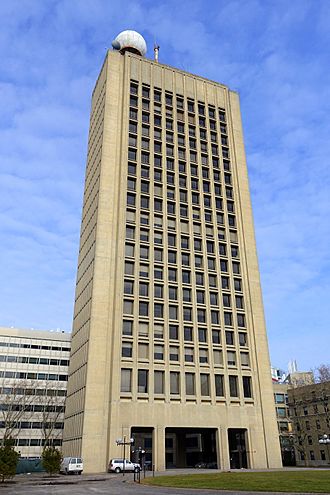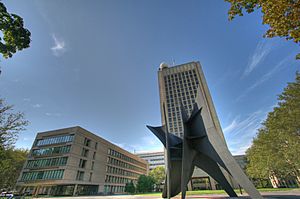Green Building (MIT) facts for kids
Quick facts for kids Cecil and Ida Green Building |
|
|---|---|

Occupied spaces of the Green Building begin 30 feet (9.1 m) above ground level.
|
|
| Alternative names | MIT Building 54 |
| Etymology | Cecil Howard Green (MIT BSEE and MSEE, 1924) |
| General information | |
| Type | Research labs, education |
| Architectural style | Brutalist |
| Location | MIT Campus - East |
| Address | 21 Ames Street |
| Town or city | Cambridge, Massachusetts |
| Country | US |
| Current tenants | MIT Earth, Atmospheric, and Planetary Sciences Department (EAPS) |
| Construction started | 1962 |
| Opened | 1964 |
| Height | |
| Architectural | 277 feet (84 m) |
| Tip | 295 feet (90 m) |
| Technical details | |
| Structural system | Shear wall |
| Material | Reinforced concrete |
| Floor count | 18 |
| Floor area | 130,502 square feet (12,124.0 m2) |
| Lifts/elevators | 3 |
| Design and construction | |
| Architect | I. M. Pei (MIT BArch, 1940) Araldo Cossutta |
| References | |
| I. Green Building at Emporis |
|
The Cecil and Ida Green Building, also known as the Green Building or Building 54, is a tall building at the Massachusetts Institute of Technology (MIT) in Cambridge, Massachusetts. It is home to the Department of Earth, Atmospheric, and Planetary Sciences (EAPS). This building is one of the tallest buildings in Cambridge.
The Green Building was designed by famous architect I. M. Pei, who studied at MIT. Another architect, Araldo Cossutta, also helped with the design. The building was named after Cecil Howard Green, who gave money for its construction. He also studied at MIT and helped start a company called Texas Instruments.
Contents
Building Design and Features
The Green Building was built between 1962 and 1964. It is made of reinforced concrete. The building has 18 floors, which is about 277 feet (84 m) tall. Its outside looks similar to older MIT buildings because it uses concrete that looks like limestone. The lowest part of the building is actually below sea level and connects to MIT's underground tunnel system.
- The building has three elevators.
- There are staircases on both the east and west sides. These staircases have large, plain concrete walls with only a few recessed panels.
The first floor you can use is called the "LL" level. It has a big lecture hall called Room 54-100. The second floor used to have a library, but it moved in 2009.
Why the Green Building is Tall
When it was finished in 1964, the Green Building was the tallest in Cambridge. It stayed the tallest until 2019. At the time it was built, there were rules about how many floors tall buildings could have. So, the Green Building was designed to be on "stilts." This means the first floor you can use is about 30 feet (9.1 m) above the ground. This design helped the building be taller while still following the rules.
The building's height is also useful for science. Its roof holds special equipment for studying weather, like meteorological instruments and weather radar. This equipment needs a clear view to work best. Without the Green Building, a separate tower would have been needed for these tools. To prevent interference with radio signals, other buildings on MIT's central campus are much shorter.
Recent Renovations
In 2019, MIT started a big renovation project for the Green Building. This project costs about $60 million. The renovation will add 12,000 square feet (1,100 m2) of new space for environmental science research. Part of the new section will be LEED-certified, meaning it's designed to be very energy efficient.
What Happens Inside
The Green Building is the main home for MIT's Department of Earth, Atmospheric, and Planetary Sciences (EAPS). This department is also known as Course 12.
- The main office for the department is on the 9th floor.
- The lower floors are used for Planetary Science.
- The middle floors are for Earth Science, which includes Geology, Geophysics, and Geochemistry.
- The upper floors are for Atmospheric Science, which also covers Oceanography and Climatology.
Building Challenges
When the Green Building first opened, strong winds were a big problem. Because the building is so tall and close to the Charles River, the wind would rush through the archway at its base. Sometimes, the wind was so strong that people couldn't use the main doors. They had to use an underground tunnel to get into other buildings.
To fix this, temporary wood panels were put up to block the wind. Later, revolving doors were installed. Also, some windows on upper floors cracked or even popped out because of the wind. All the windows eventually had to be replaced. A few years later, a similar tall building in Boston had the same wind problems.
Scientists at MIT even studied the wind around the building using models and computer programs. They confirmed that the winds at the base were unusually strong.
A popular story says that a sculpture called La Grande Voile (The Big Sail) was put in front of the building to block the wind. However, studies have shown that the sculpture is too far away to help much with the wind problem.
Fun Pranks and Displays
The Green Building is very tall and has many windows. These windows are arranged in a grid, like a giant dot-matrix display. Because of this, the building has been used for many "hacks" or pranks by MIT students.
- In 1993, students turned the top nine floors into a huge digital VU meter for a Fourth of July concert.
- Other pranks have used all the windows to create still images. This is so common that it's called greenspeak.
Tetris on the Green Building
In September 2011, students installed 153 special LED lights in almost every window. These lights could change colors and were controlled wirelessly.
- On September 11, 2011, they displayed a waving American flag to remember the September 11 attacks.
- On September 12, the lights briefly showed a game of Tetris. This was a long-time dream for MIT hackers, often called the "Holy Grail" of hacks.
The students later improved the lights to make them more reliable. On April 20, 2012, they successfully turned the Green Building into a giant, playable Tetris game. Visitors could play the game on the huge 80-by-250-foot (24 m × 76 m) display. It was said to be the second-largest full-color video display in the US at the time.
The hackers worked with the EAPS department to keep the lights installed permanently. Each light has a button that lets people inside turn off the light for their window if they are working late. The students also shared their software so others can design new displays. As of 2020, the light display was no longer working.
Other Hacks
The Tech Model Railroad Club at MIT has a small model of the Green Building on their HO scale model railroad layout. People can play a simple version of Tetris on the model, even when the club is closed.
Students have also tried other pranks using the building's height. In 1974, there was an attempt to use a giant yoyo from the roof, but it didn't work. Launching things from the roof is not allowed because of the strong winds and the danger to people below.
Special Events
Pumpkin Drop
Every year, on the last Saturday of October, students from the First West dorm drop many pumpkins from the roof of the Green Building at midnight. Many people come to watch this event. The area around the building is blocked off to keep everyone safe.
Green Building Challenge
The Green Building Challenge is a traditional event during MIT's "Bad Ideas" weekend. Teams of students compete to climb the stairs of the 18-story Green Building as many times as they can in one evening. The winning teams often climb the building about 300 times in total!
Art Around the Building
The Green Building faces a grassy area called McDermott Court. In this area, there is a large, 33-ton metal sculpture called La Grande Voile (The Big Sail). It is one of Alexander Calder's famous "stabile" artworks.
In 2011, a temporary art piece called Wind Screen was put in the archway at the base of the building. It was designed by Meejin Yoon. This artwork used small turbines that would light up when the wind blew, showing off the building's famous wind gusts.
On May 18, 2013, an artist named David Yann Robert projected an image of a scientist named Jagadish Chandra Bose onto the white dome on the Green Building's roof at night.



